Odds and Ends
Also check "Not So" for those things with Rutherford in the name which aren't named for Ernest Rutherford.
Aircraft
1960 - South Pacific Airlines of New Zealand (SPANZ) -
DC3 Viewmaster - ZK-BYD - Ernest Rutherford
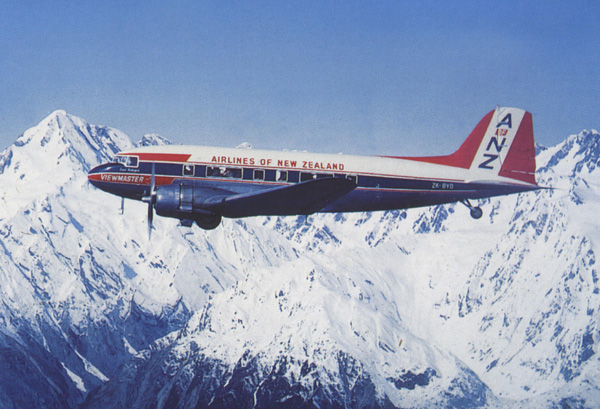
This Douglas DC3/C47A-60-DL Dakota had a long and interesting history.
Built at Long Beach in 1943 (number 43-30755) as number 13906 of the Douglas production list.
It served initially in the USAAF, 21 Troop Carrier Squadron.
On 23 August 1943 it was transferred to Australia where it served with the Pacific Air Transport Command,
the US Navy, and 21 Troop Carrier Squadron.
On 8 September 1945 it was transferred (sold?) to Australian National Airways and underwent conversion for civil use.
On 22 May 1946 it entered airline service as VH-ANK Lutana (Aboriginal for Moon). VH is the registration
suffix applied to Australian aerocraft.
On 12 September 1946 it was leased to (later purchased by) Guinea Airways as VH-AVL Bulolo (A New Guinea town).
On 31 May 1954 it was taken over by Queensland Airlines and renamed Maranoa after a Queensland river, and
operated by them until 1960.
On 5 February 1958 it was purchased by Ansett Transport Services.
On 1 April 1960 it was transferred briefly to Airlines of New South Wales.
SPANZ (South Pacific Airlines of New Zealand was formed in 1960 by two ex-pilots of NAC (National Airline
Corporation) Rex Daniell and Bob Anderson. They pioneered mid-flight meals and scheduled flights to major seconday towns.
After Ansett purchased shares in SPANZ, the DC3 underwent a conversion to Viewmaster specifications (large windows for tourism)
at Archerfield, Queensland.
On 2 December 1960 the DC3 Viewmaster arrived in New Zealand, re-licensed with a New Zealand registration number ZK-BYD.
On 14 December 1960 it started scheduled services as SPANZ's flagship and was named Ernest Rutherford early in 1961.
Two other Viewmasters were named Jean Batten and George Bolt, both early pioneer aviators in New Zealand.
As far as I know, Rutherford never ever flew in a plane.
On 28 February 1966 SPANZ ceased operations, by which time ZK-BYD had amassed 42,922 airframe hours.
It was stored at Auckland Airport and ownership was transferred to Aviation Sales (NZ) Ltd.
On 11 July 1967 it was flown to Australia and ownership transferred, as XW-PFA, to Air America, the clandestine airline of
the CIA's secret war in Laos.
It was given to General Vang Pao's Xeing Khouang Air Transport then sold to Lao United Airlines in 1969?, and Lao Air Charter
in 1972 and current to 1975.
Vang Poa, a Hmong leader and CIA financed "war-lord" immigrated to the USA in 1975 when the communists seized power in Laos.
He had 25 children by several wives.
In 4 June 2007 he was arrested for plotting a coup to overthrow the Government of Laos, released on bail of $1.5 million on
12 July 2007, and the US government dropped all charges on 18 Sept 2009.
He died aged 81 on 6 January 2011.
It is reasonably certain that ZK-BYD was destroyed in a storm in Vientiane, Laos, on 24 March 1976.
(The information on the aircraft is mostly from the Douglas Production List (Long Beach) and the book
"South Pacific Airlines of New Zealand and their DC3 Viewmasters" by Richard Waugh and Peter Layne ISBN 8-473-07183-5.)
I thank Richard and Peter for their researches on this plane and its history.
Photo courtesy of Graham Gribble via Richard Waugh.
2011 - Qantas - Boeing 737-800 ZK-ZQG - Ernest Rutherford
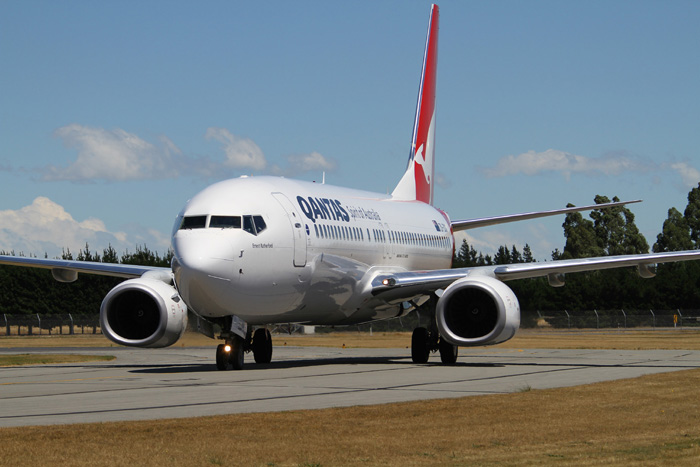 A poll of Qantas staff was held to suggest names for the seventh and eighth Boeing 737-800 aircraft scheduled to be
delivered to Qantas for trans-Tasman operations.
A poll of Qantas staff was held to suggest names for the seventh and eighth Boeing 737-800 aircraft scheduled to be
delivered to Qantas for trans-Tasman operations.
The names Ernest Rutherford and Charles Upham were chosen.
The Rutherford family gave approval for the naming on 4 May 2011.
Boeing 737-800 ZK-ZQG came off the production line at Boeing on 27 May 2011.
It was delivered to Qantas, 22 June 2011 and went into service on 28 June 2011.
It is a coincindence that 2011 was the centennial of Rutherford's discovery of the nuclear atom.
(Photo:- Bill Mallinson)
Asteroid
The International Astronomical Union's Working Group on Small Bodies Nomenclature (Bulletin 1 No 1, published 14th May 2021)
gazetted an asteroid in honour of Rutherford. The asteroid shows only as an unresolved light in reflected sunlight.
It is expected to be about 10km diameter, well out in the asteroid belt (average distance 3.04AU), with a fairly
circular orbit (e=0.09), and with an orbital period of 5.3 years.
The proposers were Alan and Pam Gilmore who first discovered it on 3/4/1981. Alan and Pam are astronomers
associated with the Mt John Observatory, New Zealand, ran by the University of Canterbury, Rutherford's old university
from which he has 5 degrees (BA, MA(Hons) BSc, DSc and DSc(Hon). Alan and Pam have discovered 41 asteroids
between 1981 and 2003. They never hunted asteroids but discovered them whilst studying Near Earth Objects (NEO) in pre-CCD days.
To the discoverer goes the honour of suggesting a name for each, but they cannot use their own names.
Alan and Pam have named nineteen of their asteroids so far, using names like Aotearoa, Aoraki, Canterbury plus various New Zealand
astronomers they knew. See their total at https://www.minorplanetcenter.net/iau/lists/MPDiscsAlpha.html
The entry states: (5311) Rutherford = 1981 GD1 Discovery: 1981-04-03 / A. C. Gilmore, P. M. Kilmartin / Lake Tekapo / 474
Ernest Rutherford (1871–1937), born and educated in New Zealand, won the 1908 Nobel Prize for Chemistry for his
work on radioactive disintegration of elements. He was the first to develop radioactive dating of the Earth,
established the nuclear atom, and predicted the existence of the neutron.
Note that an earlier asteroid named Rutherfordia was named after the town in New York State. It is often wrongly
assumed to be named after Ernest Rutherford.
Beer - Atom Splitter
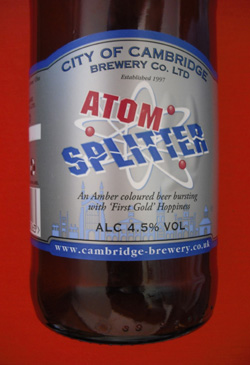
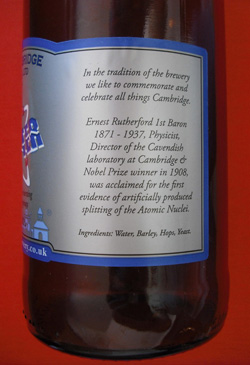 The City of Cambridge Brewing Company was founded by Steve Draper in 1997.
The City of Cambridge Brewing Company was founded by Steve Draper in 1997.
It launched this contract brewed beer in 1998 to honour Rutherford.
It makes an interesting and pleasant libation for a visiting scientist.
First in the Old Ales/Strong Milds category of the 25th Cambridge Beer Festival (1998), Atom Splitter has an ABV of 4.5%.
Atom Splitter is sold in casks and bottles.
The City of Cambridge Brewery Co Ltd (www.cambridge-brewery.co.uk) is now owned by Wolf Brewery.
They are searching for a pub in Cambridge to install a microbrewery.
Boot - No8 Footwear Company
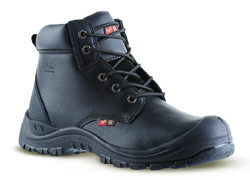 The No8 Footware Company (Pukekohe) was founded by Safety At Work Ltd in 2008 to make safety work boots for New Zealand feet.
The No8 Footware Company (Pukekohe) was founded by Safety At Work Ltd in 2008 to make safety work boots for New Zealand feet.
Its products were named after New Zealand legends, including Rutherford, Billie T James (entertainer) and William Hamilton
(inventor of the jet boat). no8footwear.co.nz
Canadian Science and Technology Hall of Fame
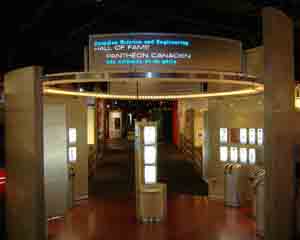 Ernest Rutherford was inducted into the Canadian Science and Technology Hall of Fame on the 26th of April 2007.
Ernest Rutherford was inducted into the Canadian Science and Technology Hall of Fame on the 26th of April 2007.
There were two other inductees that year (Chalmers Jack Mackenzie and Hubert Reeves).
Amongst those present were Mary Fowler (Rutherford's great-granddaughter), Arthur Carty
(Scientific Advisor to the Canadian Government), David Lockwood (NRL and nominator of Rutherford), myself,
and many people representing science and technology in Canada.
The Canadian Science and Technology Hall of Fame was established by the National Research Council
to mark its 75th Anniversary in 1991, the suggestion of Dick Bougeois-Doyle.
Initially it was in the corridor of their headquarters building, at 100 Sussex but, after 5 years, NRC decided
it needed a higher profile. In 1996 it was shifted to the Canadian Museum of Science and Technology in order to make it more
accessible to schoolchildren and the public.
Rutherford was the 40th inductee.
Cancer Centres (Rutherford)
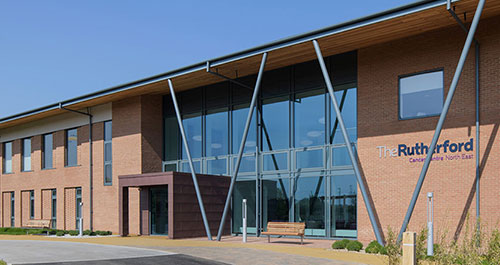
Rutherford Health Plc set up the Rutherford Cancer Centres starting in 2017.
From their website, "The centres take their name from renowned scientist and Noble Prize winner, Ernest Rutherford,
whose contribution to identifying (1909-1919) and naming of the proton (1920) saw him recognised as the
father of nuclear physics."
Eight centres will eventually cover the UK with currently (2019) four open at Newport, Bedlington,
Liverpool and Reading. The other four will open in the next four years. They specialise in all forms of cancer
diognostics and treatment and have proton accelerator treatment. Linear accelerators were first developed at the Cavendish by
Cockcroft and Walton, under Rutherford's direction.
back to top
Crater - Mars
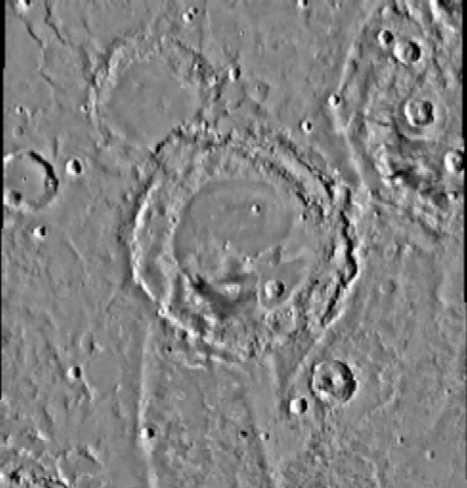
The large central crater of the photo is Rutherford.
Off picture to the northeast are craters named Becquerel and Curie.
Rutherford is located at 19.2N, 10.7W and is 110.5km in diameter.
It was named in 1973 after "Ernest Rutherford, British Physicist 1871-1937."
Crater - Moon
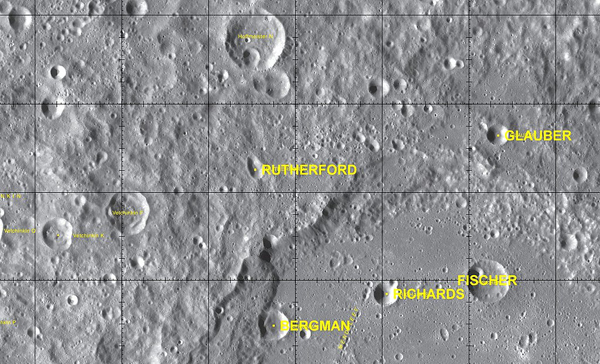 Rutherford is located at 10.7N, 45.1W and is 13km in diameter.
Rutherford is located at 10.7N, 45.1W and is 13km in diameter.
It was named in 1976 after "Sir Ernest Rutherford, British Physicist; Nobel Laureate (1871-1937)."
It is an insignificant crater just outside the rim of the Mendeleev crater.
Crater Schuster 4.2N, 33.5W, named for Sir Arthur Schuster who stepped down
in order to attract Rutherford back to England (Manchester) in 1907, is nearby.
Mineral - Rutherfordine (UO2CO3)
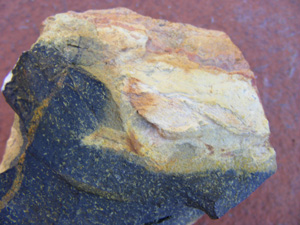 This yellow mineral, uranyl carbonate (UO2CO3), from the then German East Africa was named for
Rutherford in 1906 by Dr Marckwald (centralblatt Min., 1906 p763 - Rutherfordin).
This yellow mineral, uranyl carbonate (UO2CO3), from the then German East Africa was named for
Rutherford in 1906 by Dr Marckwald (centralblatt Min., 1906 p763 - Rutherfordin).
Its crystal structure is orthorhombic Imm2 with a = 0.480nm, b = 0.9273nm and c = 0.4298nm. Z=2. Density 5.7g/cm3.
Biaxial. It is the only known mineral that contains only uranyl carbonate.
Normally yellow to amber lathe like crystals up to 3mm in length. It has been reported in
Tanzania, Zaire and the Northern Territory of Australia. The sample illustrated was given to me by Brian Mason,
New Zealand born and educated and an Hon FRSNZ, who was mineralogist at the Smithsonian Institute.
On 19 July 1906 Mackwald wrote to Rutherford saying he planned to name the mineral "Rutherfordit" in
Rutherford's honour. On 11 Aug 1906 Rutherford responded accepting the honour and stating "I am not sufficently well
acquainted with names to know whether the "Rutherfordit" has previously been used in minerology, or not." He finished with
"P.S. I shall be very interested to see any literature you publish on the new mineral and should be
very much obliged if it is possible to forward me a small sample of the same."
In a 1 Mar 1907 letter to Bertram Boltwood, Rutherford stated "My mineral "Rutherfordite" is an
excellent thing to work with as it all dissolves in HCl." Note that the mineral Rutherfordite is not named for our
Ern but, by an earlier claimant in 1851, for Rutherford County, North Carolina, where it his mineral was first found
in the gold bearing sands. In 1880 the original name claimant (an American geologist Charles Upton Shepard) found
his to be another mineral (Fergusonsite) so the original name presumeably lapsed. Mackwald registered his in German
as Rutherfordin.
Mountain
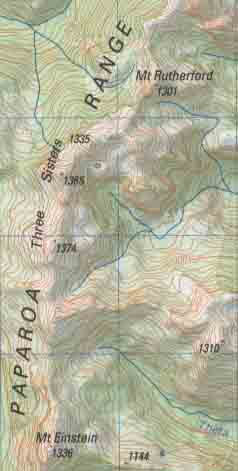 In 1968-71 Simon Nathan, then working for the NZ Geological Survey, DSIR,
prepared a geological map of the northern part of the Paparoa Range, in the northern
part of the West Coast of the South Island, New Zealand. The existing topographic map
was poor, with only two of the highest peaks previously named by Haast in honour of famous scientists
of his day (Kelvin (1434m) and Faraday (1485m)).
In 1968-71 Simon Nathan, then working for the NZ Geological Survey, DSIR,
prepared a geological map of the northern part of the Paparoa Range, in the northern
part of the West Coast of the South Island, New Zealand. The existing topographic map
was poor, with only two of the highest peaks previously named by Haast in honour of famous scientists
of his day (Kelvin (1434m) and Faraday (1485m)).
Lands and Survey were getting ready to prepare a new version
based on aerial photographs. Simon needed to give some features names so that he could
refer to them, so made up a list of names of famous scientists that had not already been
used, including Mt Rutherford. At 1301m it is the lowest of the named peaks. He submitted the
list to the NZ Geographic Board in 1971, and most of the names were later approved and
gazetted. A second round was named in 1973-74.
Mounts Einstein, Pasteur, Mendel, Curie, Faraday, Priestly, Dewer, Ramsay and Lodge are to the south,
with Euclid, Fleming, Lavoisier and Kelvin to the north.
back to top
Parks and Reserves
Lord Rutherford Park,
Brightwater, Nelson, New Zealand, is a Tasman District Council reserve
not far from the place of Rutherford's birth.
In May of 2008 the Tasman District Council purchased another 9000 square metres of adjacent land, to add sports fields and a
cricket field to the park.
Parc Rutherford,
McGill University, Montreal, Canada, is build on the top of the
McTavish reservoir. It has a football field and in winter is used as a dumping ground for snow from road and footpath clearance.
Racehorse - NZ
Ernestlordrutherford,
a gelding - sire Soky's Atom, dame Elysian Fields, foal date 29th Feb 2001, was registered 29th May 2002
and qualified for all weather racing at Rangiora on 20th June 2006.
It had its first win at the Rangiora Harness Races 3rd Race 15th July 2006. He was named by owners Denise Bourne
and Doug Martin, and trained by Andrew McPherson of Woodend. His stable name was Ritchie after Ritchie McCaw,
the captain of the All Blacks rugby team. (Rutherford played lock in his rugby playing days at Nelson College
and Canterbury College.)
It had a lifetime record as a 4, 5 and 6-year-old of 45 starts, 5 firsts, 8 seconds and
5 thirds with net stakes won of $52,474. It last raced on 29th February 2008 at Hororata, and was later sold or
given away as a hack. Ernestlordrutherford has been described as a good honest racehorse, but not of the top rank.
Retirement Village - Ernest Rutherford - Nelson - NZ
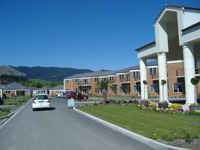 The Ernest Rutherford Retirement Village, one of many Ryman Healthcare retirement villages named for
well-known New Zealanders, was opened on June 20th 2008.
The Ernest Rutherford Retirement Village, one of many Ryman Healthcare retirement villages named for
well-known New Zealanders, was opened on June 20th 2008.
It is at 49 Covent Drive, Stoke, Nelson, and has 112 independent living townhouses, 48 assisted
living serviced apartments, and 77 care centre (rest-home, hospital, dementia) beds.
Ridge - Antartica
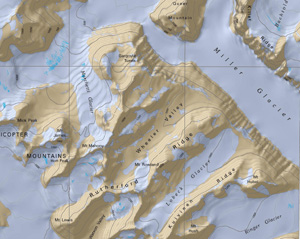 Rutherford Ridge (77°12'01"S 161°43'45"E) is a transveres ridge 10.2km long across the Saint Johns range, high above
the Miller Glacier, west of Scott Base in Victoria Land, Antarctica.
Rutherford Ridge (77°12'01"S 161°43'45"E) is a transveres ridge 10.2km long across the Saint Johns range, high above
the Miller Glacier, west of Scott Base in Victoria Land, Antarctica.
It was named after Ern in 2007, amongst 36 names following a joint USGS-LINZ project, by the US Advisory Committee
on Antarctic Names (ACAN). These names were used in a new series of digital 1:50km topographic maps issued in 2009.
Rotary Club of Rutherford Nelson - NZ
 This Rotary Club was chartered on the 9th of October 1981 as the Rotary Club of Nelson Central and had its
first meeting on the 13th of October 1981. Because of the similarity of name to the Rotary Club of Nelson, in 2001 the
members proposed the name be changed to The Rotary Club of Rutherford Nelson to honour Baron Rutherford of Nelson.
The Board of Directors of Rotary International approved the name change on the 11th of December 2001.
It meets at 5pm on Monday evenings.
This Rotary Club was chartered on the 9th of October 1981 as the Rotary Club of Nelson Central and had its
first meeting on the 13th of October 1981. Because of the similarity of name to the Rotary Club of Nelson, in 2001 the
members proposed the name be changed to The Rotary Club of Rutherford Nelson to honour Baron Rutherford of Nelson.
The Board of Directors of Rotary International approved the name change on the 11th of December 2001.
It meets at 5pm on Monday evenings.
back to top
Window - Stained Glass - St Mary's Church, Stoke Newington, London.
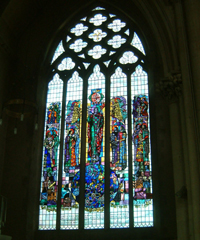
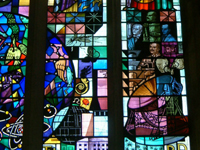 On the 15th of October 1940, a German bomb destroyed many artifacts in St Mary's Church. On WhitSunday 1960,
the new, stained-glass, north window was dedicated. It featured famous scientists. Rutherford is in the right hand
panel and his nuclear atom is in the centre.
On the 15th of October 1940, a German bomb destroyed many artifacts in St Mary's Church. On WhitSunday 1960,
the new, stained-glass, north window was dedicated. It featured famous scientists. Rutherford is in the right hand
panel and his nuclear atom is in the centre.
St Mary's Church is on Stoke Newington Church St, London, N16 9ES, opposite Clissold Park,
about a mile from Stoke Newington Rail Station.
(Photographer - Jonathan Gebbie.)
Street Art, Christchurch NZ
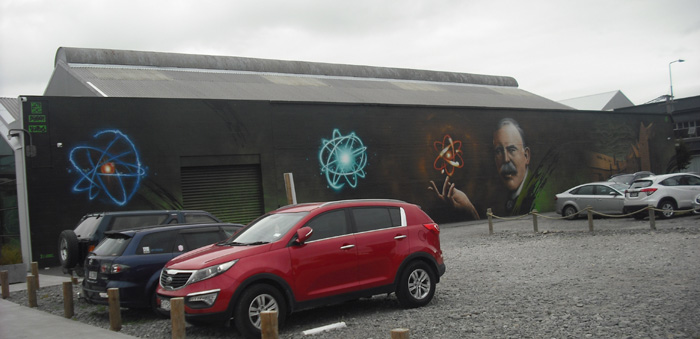 After the Earthquakes in 2010-11, many buildings were pulled down leaving unsightly walls around temporary car parks until
the buildings were to be rebuilt. Many walls were thus temporarily decorated with street art. No city had so many walls available. Some street
art walls have been built out but even in 2022 there are many walls still available. Plus some large ones that existed alongside car parking areas.
After the Earthquakes in 2010-11, many buildings were pulled down leaving unsightly walls around temporary car parks until
the buildings were to be rebuilt. Many walls were thus temporarily decorated with street art. No city had so many walls available. Some street
art walls have been built out but even in 2022 there are many walls still available. Plus some large ones that existed alongside car parking areas.
In Feb 2022 the long West wall of Team Hutchison Ford workshop was painted with a mural honouring Ernest Rutherford and his nuclear atom,
as part of the Flare Street Art Festival.
It is excellent, showing Canterbury College, Rutherford, and several illustrations of his nuclear atom.
It is just a pity that the artists didn't confire with me first, before getting images from google. His nuclear model of the atom dates from 1911
but his portrait is based on a photograph taken much later in life looking much older and quite grey. I could have put them onto a 1916 potrait
painting that gave his true likeness closer to the time. The bottom left title "Sir Ernest Rutherford, Canterbury College graduate, 1895"
would have been more accurate had it been "Ernest Rutherford, Canterbury College, 1890-94". 1895 was the year he left New Zealand and he was "Mr"
there. Later he became "Professor", "Dr", "Sir", and died as "Lord".
Street Names
New Zealand
Lord Rutherford Road,
Brightwater,
was renamed in honour of Ernest Rutherford who was born on that highway, part of the then
main road (State Highway S6) between Nelson and the West Coast. To eliminate 4 right angle
bends, and to avoid having the main road pass through the village, the Brightwater Bypass
was constructed. This used the old Nelson to Wakefield railway line which had been closed
in 1956. It divided Lord Rutherford Road into North and South. The Rutherford Birthplace
is at the junction of the Brightwater Bypass and Lord Rutherford Road (North).
Rutherford Street, Nelson,
was re-named so sometime between 1939 and 1945. It is
surmised it was named for Rutherford who died in 1937. Previously called Waimea Street, it
needed renaming because of confusion with Waimea Road. There was talk at the time of a
memorial to Rutherford. This may be it. Further details would require a search of the NCC
minute books for the war period. This would be simplified by a newspaper search for the
advertisements of a business, located in the street, which advertised on a regular basis.
Rutherford Street,
Woolston, Christchurch. Princess Street in Woolston was renamed
Rutherford Street from the 1st of Sept 1948 when the Woolston Borough Council was
amalgamated into Christchurch City which already had a Princess Street. Rutherford Street
is assumed to be named for Ernest Rutherford though there is no confirming evidence in the
council minutes for the 23rd of Aug 1948. It was just one of 137 streets renamed at
that meeting. Just after the bend where Rutherford Street changes into King Edward Terrace
is a private lane called, unofficially, Atom Lane. After crossing the Heathcote River, the other end of
Rutherford Street terminates at Ferry Road.
Rutherford Drive,
Waikanae Beach North, is in a subdivision contributed to by William
and Lydia Pharazyn between 1967 and 2002. The last new street in the subdivision was named
Pharazyn Drive. Several other streets were named for various relatives. Two, Rutherford
Drive (1967) and Freyberg Crescent (1968), were named for prominent New Zealanders
"apparently for no other reasons but their status." William Pharazyn
features in the Dictionary of New Zealand Biography (www.dnzb.govt.nz).
Rutherford Street, Lower Hutt
, was named "after the late Lord Rutherford" by the Lower Hutt City Council's By-Laws, Health, Library and
Band Committee on the 2nd of April 1952.
Rutherford Street, Takapuna,
was a new street in the Hughes block, off Eversleigh Rd.
It was so named by the Works, Parks and Reserves Committee of the Takapuna City Council on
the 12th of Oct 1954 at the recommendation of Cr Henderson. At the same time, he
recommended a new street in the Sussex block be called Marsden Street. (Actually he
proposed either Terrace or Street for both, the council selected Street for both.) Thus it
is a reasonable assumption the street was named for Ernest Rutherford.
Rutherford Road,
Marewa, Napier, was, according to Ian Mill's book on Napier Street
names, named for Ernest Rutherford. I haven't sighted the council minutes. Marewa was
planned in 1929-30 and developed in 1931-4. The Harbour Board were invited to name the
streets which they did in the main after Harbour Board members, NZ Prime Ministers, a VC
winner and some locals. Ian points out that there is also a Nuffield Avenue and this would
be in keeping with an apparently policy of Napier of including scientists and
industrialists amongst street names.
Rutherford Street, Hamilton,
was, according to card M21 which seems to have been entered in 1981, named after "Baron Rutherford of Nelson"
in 1963, by the subdividers of the land, Chedworth Park Ltd. The council minutes for 1963 need checking for confirmation.
Rutherford Street, Tauranga,
is assumed to be named after Ernest Rutherford. Alex
Gallagher, the developer of the Rutherford Street subdivision in 1951, wasn't sure who it
had been named after but as there was no one named Rutherford associated with the
development he assumes it was named for Ernest Rutherford. The Tauranga District Council
was unable to find any mention of why Rutherford Street was so named.
Canada
Rutherford Ave, Deep River.
During World War Two the British and Canadian nuclear energy programme was based at Chalk River, on
the banks of the Ottawa River, an isolated area with a good water supply, two hours drive from Ottawa.
Canada's first nuclear reactor first operated in 1945. Houses for the young scientists and engineers,
and their families, were built at nearby Deep River (up-stream and up-wind of Chalk River)
in 1944. Several new streets were named for prominent physicists. These include not only
Faraday Cres and Kelvin Cres but also Thomson Cres (who discovered the electron whilst
Rutherford was helping him with his experiments), Chadwick Drive (who discovered the neutron
twelve years after Rutherford told him it had to exist), and Brockhouse Way (a Canadian
awarded the Nobel Prize for the "Devlopment of Neutron Diffraction" at Chalk River.)
England
Rutherford Road, Cambridge, CB2 8HH.
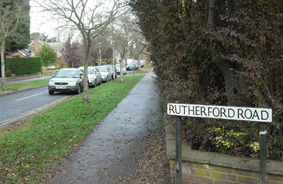 Follow Trumpington Rd, (A1134) south to where the A1134 turns left into Long Road. Rutherford Rd is 600m
on the left. It is one of many roads, built on Trinity College land, named for illuminaries of Trinity College.
("Cambridge Street Names - Their Origins and Associations", Gray and Stubbings, Cambridge University Press, 2000.)
Follow Trumpington Rd, (A1134) south to where the A1134 turns left into Long Road. Rutherford Rd is 600m
on the left. It is one of many roads, built on Trinity College land, named for illuminaries of Trinity College.
("Cambridge Street Names - Their Origins and Associations", Gray and Stubbings, Cambridge University Press, 2000.)
Rutherford Ave,
Didcot, Oxfordshire OX11 0DF, on the
Harwell Campus. Other streets in this area include Thomson Ave, Becquerel Ave, Maxwell Ave, Faraday Ave,
Fermi Ave and Curie Ave. The British government set up Atomic Energy Research Establishment (AERE) at Harwell in 1945
under John Cockcroft. It was to build on World War 2 nuclear research to develop nuclear power for energy generation
and for military purposes. Starting in the 1980s AERE was supposed to produce its own money, becoming in 2006 the Harwell
Science and Innovation Centre, a 50:50 Public/Private joint venture.
Rutherford Drive, Wellingborough,
Northamptonshire NN8 6AQ , An Industrial Estate, Park Farm South, was established in Wellingborough with Enterprise
Funding in the early 1980s, and was developed in the late 1980s.
The main road south of Sywell Rd was called Rutherford Drive in honour of Ernest Rutherford. Names of roads running off it
include Ryle (radioastronomy), Napier (Mathematics) and Wallis (geodesic aircraft frame and bouncing bomb). Street names in the
estate north of Sywell Rd include Faraday, Newton, Edison, Sinclair (computing), Baird (TV),
Whittle (jet engine), Brunel (engineering), and Fleming (penicillin).
Rutherford Way, Tonbridge,
Kent WD23 1NJ, Almost certainly named for Ernest as the other streets in this newish? estate are named Cavendish,
Faraday, Newton, Kelvin, Priestly, Fleming, and Darwin.
Germany
Rutherfordstrasse, in the Aldershof district of
Berlin, is in a
science park area which houses, for example, the Deutschen Zentrum fur Luft- and Raumfahrt
(DLR, the German Aerospace Center). One block north of the Teltowkanal at Wegedornstrasse,
Rutherfordstrasse's north end starts on Rudower Chaussee and its southern end terminates
on Albert-Einstein-Strasse. Other scientists recognised by street names in this area
include Max-Planck-Strasse and Gustav-Kirchhoff-Strasse to the east and
Ludwig-Boltzmann-Strasse to the north.
Holland (Netherlands)
Rutherfordweg, in the Binnenhofbuurt district in the north of
Rotterdam, is part of
a development starting about 1985 which turned previous grass-land into houses and a shopping mall.
Many other new streets were named for Nobel Prize-winners, including Debije-weg, Bohr-plaats,
and Curie-plaats. (Thanks to Lean Ermstrang for pointing out this street.)
Train - Rutherford of Nelson
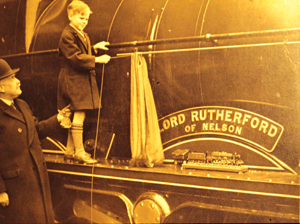 On the 10th Dec 1935 the London Midland and Scottish (LMS) Railway company planned to
hold an opening of the LMS Research Laboratory at Derby. A new train (built November 1935) was
detailed to bring the invited guests from London, with speeches on the way. This was the Jubilee
engine No 5665, in the middle of a group of engines built at Crewe and being named for a long list
of British Admirals. Because the President of the Royal Society (Lord Rutherford) was to officiate,
the engine was to be called "Lord Rutherford of Nelson".
On the 10th Dec 1935 the London Midland and Scottish (LMS) Railway company planned to
hold an opening of the LMS Research Laboratory at Derby. A new train (built November 1935) was
detailed to bring the invited guests from London, with speeches on the way. This was the Jubilee
engine No 5665, in the middle of a group of engines built at Crewe and being named for a long list
of British Admirals. Because the President of the Royal Society (Lord Rutherford) was to officiate,
the engine was to be called "Lord Rutherford of Nelson".
Rutherford's oldest grandson, (Peter Fowler) was away at boarding school so his second
grandson, Patrick, was chosen for the unveiling at St Pancras Station prior to the train's departure
to Derby. When Patrick unveiled the nameplate, behind the curtain was a clockwork model of the train
made by the apprentices at Crewe. Patrick was then led to the front of the train and the model
presented to him.
The train, with its whitewashed coal and its guests, then departed for Derby whilst Patrick
returned to his home in Cambridge to show off his model to the rest of the family. Patrick treasured
that model and about 2000 gave it to The Rutherford Den in Christchurch, New Zealand. The actual train
was not a good steamer and was retired 27 years later in December of 1962 as No 45665. (Thanks to
www.jubilees.co.uk for details of the actual train.)
U3A (University of the Third Age)
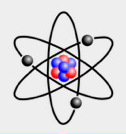 There are 90 U3A in New Zealand with 15 in Christchurch. These educational organisations
exist for retired people (hence the third age).
There are 90 U3A in New Zealand with 15 in Christchurch. These educational organisations
exist for retired people (hence the third age).
U3A Rutherford was founded in 2002, with Rutherford being selected as a name associated
with Christchurch, being the internationally most famous graduate of what is now known as the University
of Canterbury. It has a membership in excess of 300 and organises annually 5 courses of 5 lectures each
and one course of 4 lectures. Each course is usually separated by a two week break. U3A Rutherford also
has 9 small special interest groups such as Art, Book, Cinema, Choir, Epicurean, Travel and Walking.
The current maximum limit on members is 350 so there is no waiting list.
UKAEA Coat of Arms
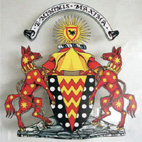 When the UK Atomic Energy Authority were granted its Coat of Arms on Apr 12th 1955,
it was surmounted by one element from Rutherford's Coat of Arms, the legless martlet, which he had
taken from the Rutherford family Coat of Arms.
When the UK Atomic Energy Authority were granted its Coat of Arms on Apr 12th 1955,
it was surmounted by one element from Rutherford's Coat of Arms, the legless martlet, which he had
taken from the Rutherford family Coat of Arms.
Unit of Radiation - The rutherford (Rd)
As the
person who brough precision to many measurements, Rutherford needed standards and
championed international standards. In the meantime he needed his own. The general unit of
radioactivity was the rutherford (Rd), the amount of radioactive isotope which
disintegrated at the rate of a million disintegrations per second. At the start of the
International Congress on Radiology and Electricity for 1910, Ern read a report on the
necessity of establishing an international standard for radium. The congress set up a
committee, of which Rutherford was a key member. The committee reported back at the final
session recommending that a standard be established, that Marie Curie be authorised to
produce the international standard radium sample containing about 20 milligrams of radium,
that all countries produce their own standard which could be calibrated against the
international standard, and that the standard be given the name curie (Ci) after her
husband, the late Pierre Curie who had been killed instantly when he slipped and was run
over by a horse-drawn dray in 1906. This was done.
The Curie was the number of nuclei which
disintegrated in one second from one gram of radium (37 thousand million). So one
rutherford = 1/37 millicuries. Initially the Curie was only used for radium. The
rutherford was made redundant in 1953 and the curie in 1975. The unit of radioactive decay
today is the becquerel, (Bq) being one disintegration per second. So one rutherford was a
million becquerel.
Wine - Lord Rutherford label
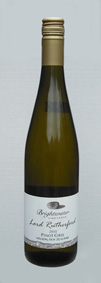
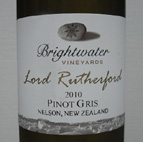
The Brightwater vineyard is the closest to the Rutherford Birthplace at Brightwater, Nelson Province, New Zealand.
Not open to public tastings. They regularly market some of their wines under the additional name "Lord Rutherford", which makes
a nice present for an overseas scientist. (Orders via www.brightwaterwine.co.nz).
They also currently export their wines to Australia.
back to top

